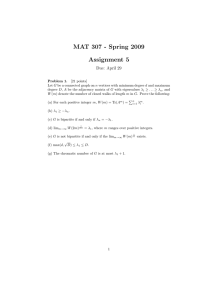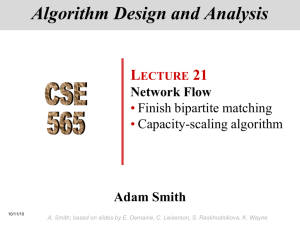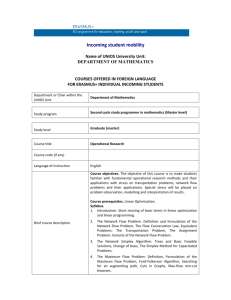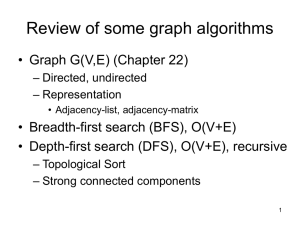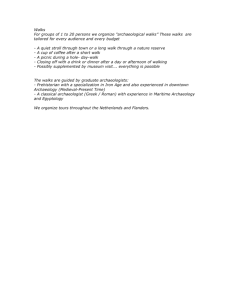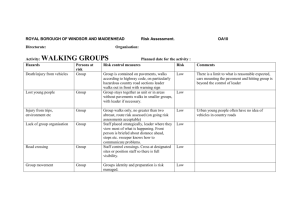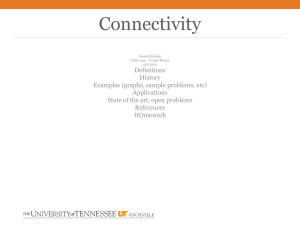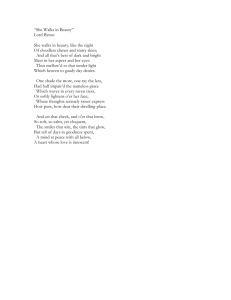Transport problems 18.S995 - L20
advertisement
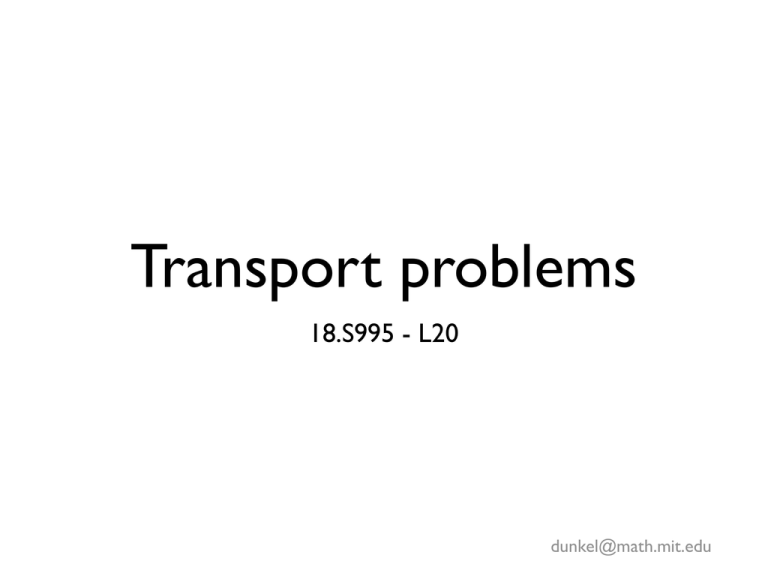
Transport problems
18.S995 - L20
dunkel@math.mit.edu
Root systems
Katifori lab, MPI Goettingen
Maze solving
time = 0
1 cm
after 8 hours
Nakagaki et al (2000) Nature
dunkel@math.mit.edu
Tree graphs
Spanning trees
Minimal spanning tree
Kirchhoff’s theorem
Number of spanning trees
L
L 11
sufficient to consider since row and column sums
of Laplacian are zero
det L 11 =8
Max-Flow Min-Cut
An example of a flow network with a maximum flow. The source is s, and the sink t. !
The numbers denote flow and capacity.
Deterministic transport
DU/~cos226
Maximum Flow and Minimum Cut
Max flow and min cut.
Max Flow, Min Cut
!
Two very rich algorithmic problems.
!
Cornerstone problems in combinatorial optimization.
!
Beautiful mathematical duality.
Nontrivial applications / reductions.
!
!
!
!
!
!
Network connectivity.
Bipartite matching.
Data mining.
Open-pit mining.
Airline scheduling.
Image processing.
!
Project selection.
!
Baseball elimination.
Source:
Minimum cut
Maximum flow
Network reliability.
Max-flow min-cut theorem
!
Security of statistical data.
Ford-Fulkerson
augmenting path algorithm
Distributed computing.
!
!
Edmonds-Karp
heuristics
Egalitarian stable
matching.
!
Bipartite
matching
Distributed
computing.
!
!
Many many more . . .
2
Princeton University • COS 226 • Algorithms and Data Structures • Spring 2004 • Kevin Wayne •
http://www.P
Soviet Rail Network, 1955
Max Flow, Min Cut
Minimum cut
Maximum flow
Max-flow min-cut theorem
Ford-Fulkerson augmenting path algorithm
Edmonds-Karp heuristics
Bipartite matching
Source: On the history of the transportation and maximum flow problems.
Alexander Schrijver in Math Programming, 91: 3, 2002.
Source:
Princeton University • COS 226 • Algorithms and Data Structures • Spring 2004 • Kevin Wayne •
s
3
http://www.P
U/~cos226
2
Minimum Cut Problem
Max Flow, Min Cut
Network: abstraction for material FLOWING through the edges.
!
Directed graph.
!
Capacities on edges.
!
Source node s, sink node t.
Min cut problem. Delete "best" set of edges to disconnect t from s.
Minimum cut
Maximum flow
source
s
capacity
3
Max-flow min-cut theorem
2
9
10
4
15
5
3
8
6
10
15
4
6
15
10
4
30
7
5
Ford-Fulkerson augmenting path algorithm
Edmonds-Karp
heuristics
15
10
Bipartite matching
t
sink
4
Source:
Princeton University • COS 226 • Algorithms and Data Structures • Spring 2004 • Kevin Wayne •
http://www.P
Cuts
Max Flow, Min Cut
A cut is a node partition (S, T) such that s is in S and t is in T.
!
capacity(S, T) = sum of weights of edges leaving S.
10
s
5
15
9
4
15
Max-flow
min-cut theorem
15
3
8
Edmonds-Karp
heuristicst
6
4
6
4
!
Minimum cut
2
S
A
5
Maximum flow
10
Ford-Fulkerson augmenting path algorithm
10
Bipartite matching
30
15
7
10
Capacity = 30
5
Source:
Minimum Cut Problem
Princeton University • COS 226 • Algorithms and Data Structures • Spring 2004 • Kevin Wayne •
http://www.P
Cuts
Max Flow, Min Cut
A cut is a node partition (S, T) such that s is in S and t is in T.
!
capacity(S, T) = sum of weights of edges leaving S.
Minimum cut
2
10
5
s
S
= 30
15
4
9
15
3
8
4
6
4
30
5 flow
Maximum
Max-flow min-cut theorem
15
10
Ford-Fulkerson augmenting path algorithm
Edmonds-Karp heuristics
6
10
15
10
Bipartite matching
7
5
t
Capacity = 62
6
Source:
Maximum Flow Problem
Princeton University • COS 226 • Algorithms and Data Structures • Spring 2004 • Kevin Wayne •
http://www.P
5
Minimum Cut Problem
Max Flow, Min Cut
A cut is a node partition (S, T) such that s is in S and t is in T.
!
N
capacity(S, T) = sum of weights of edges leaving S.
!
!
Min cut problem. Find an s-t cut of minimum capacity.
!
M
Minimum cut
2
10
5
s
S
15
4
3
4
4
9
15
8
6
30
!
Maximum5 flow
!
Max-flow min-cut theorem
15
10
Ford-Fulkerson augmenting path algorithm
Edmonds-Karp heuristics
6
10
Bipartite matching
15
7
t
sourc
10
Capacity = 28
7
Source:
Princeton University • COS 226 • Algorithms and Data Structures • Spring 2004 • Kevin Wayne •
http://www.P
5
6
Maximum Flow Problem
Max Flow, Min Cut
Network: abstraction for material FLOWING through the edges.
!
Directed graph.
!
Capacities on edges.
!
Source node s, sink node t.
same input as min cut problem
Max flow problem. Assign flow to edges so as to:
!
cut vertex.
Equalize inflow and outflow at everyMinimum
intermediate
!
Maximize flow sent from s to t.
10
source
s
capacity
y = 28
7
Maximum flow
2
9
4
15
5
3
8
15
4
4
Max-flow min-cut theorem
5
Ford-Fulkerson augmenting path algorithm
15
Edmonds-Karp
heuristics
10
Bipartite matching
6
10
6
15
10
30
7
t
sink
8
Source:
Princeton University • COS 226 • Algorithms and Data Structures • Spring 2004 • Kevin Wayne •
http://www.P
Flows
A flow f is an assignment of weights to edges so that:
Max Flow, Min Cut
!
Capacity: 0 ! f(e) ! u(e).
!
Flow conservation: flow leaving v = flow entering v.
A
!
!
except at s or t
4
10
s
capacity
flow
0
5
15
0
2
0
9
Minimum5cut
4 4
0
15
0
Max-flow
15 min-cut
0
10 theorem
3
4
8
4 0
0
6
4
0
30
Maximum flow
Ford-Fulkerson augmenting path algorithm
6
Edmonds-Karp
4
t
heuristics
10
Bipartite matching
0
15 0
7
10
Value = 4
9
Maximum Flow Problem
Source:
Princeton University • COS 226 • Algorithms and Data Structures • Spring 2004 • Kevin Wayne •
http://www.P
Flows
Max Flow, Min Cut
A flow f is an assignment of weights to edges so that:
!
Capacity: 0 ! f(e) ! u(e).
!
Flow conservation: flow leaving v = flow entering v.
except at s or t
10
10
s
capacity
flow
3
5
15
11
Minimum cut
2
6
9
4 4
0
15
Max-flow min-cut6theorem
3
8
8
8
Edmonds-Karp heuristics
4 0
1
6
4
Maximum5 flow
15 0
10
Ford-Fulkerson augmenting path algorithm
6
10
15 0
10
10
Bipartite matching
11
30
9
7
t
Value = 24
10
Source:
Flows and Cuts
Princeton University • COS 226 • Algorithms and Data Structures • Spring 2004 • Kevin Wayne •
http://www.P
9
Maximum Flow Problem
Max Flow, Min Cut
Max flow problem: find flow that maximizes net flow into sink.
10
10
s
capacity
flow
4
5
15
14
Obs
net f
Minimum cut
2
9
9
4 0
1
15
Max-flow min-cut theorem
3
8
8
Edmonds-Karp
heuristics
6
t
10
4 0
4
6
4
14
30
5
Maximum flow
15 0
9
10
Ford-Fulkerson augmenting path algorithm
9
Bipartite matching
15 0
7
10
10
Value = 28
11
Source:
Princeton University • COS 226 • Algorithms and Data Structures • Spring 2004 • Kevin Wayne •
http://www.P
9
10
Flows and Cuts
Max Flow, Min Cut
Observation 1. Let f be a flow, and let (S, T) be any s-t cut. Then, the
net flow sent across the cut is equal to the amount reaching t.
10
10
s
S
28
11
4
5
10
15
Minimum cut
2
6
9
4 4
0
15
6
Max-flow min-cut
theorem
3
8
8
8
Edmonds-Karp
heuristics
6
t
4 0
0
6
4
10
30
5
Maximum
flow
15 0
10
Ford-Fulkerson augmenting path algorithm
10
Bipartite matching
15 0
7
10
10
Value = 24
12
Source:
Princeton University • COS 226 • Algorithms and Data Structures • Spring 2004 • Kevin Wayne •
http://www.P
Flows and Cuts
Max Flow, Min Cut
Observation 1. Let f be a flow, and let (S, T) be any s-t cut. Then, the
net flow sent across the cut is equal to the amount reaching t.
10
10
s
S
4
5
10
15
2
6
9
Minimum cut
4 4
0
15
Max-flow
min-cut theorem
15
3
8
8
Edmonds-Karp
heuristicst
6
4 0
0
6
4
10
30
Ob
net
5
Maximum flow
0
6
10
Ford-Fulkerson augmenting path algorithm
8
10
Bipartite matching
15 0
7
10
10
Value = 24
13
Source:
Flows and Cuts
Princeton University • COS 226 • Algorithms and Data Structures • Spring 2004 • Kevin Wayne •
http://www.P
Flows and Cuts
Max Flow, Min Cut
he
Observation 1. Let f be a flow, and let (S, T) be any s-t cut. Then, the
net flow sent across the cut is equal to the amount reaching t.
10
10
s
S
24
4
5
10
15
Minimum cut
2
6
9
Max-flow min-cut6 theorem
4 4
0
15
3
8
8
Edmonds-Karp heuristics
8
4 0
0
6
4
10
30
Maximum5 flow
15
0
10
Ford-Fulkerson
augmenting
path algorithm
6
10
Bipartite matching
15 0
13
7
t
10
10
Value = 24
14
Source:
Max Flow and Min Cut
Princeton University • COS 226 • Algorithms and Data Structures • Spring 2004 • Kevin Wayne •
http://www.P
13
Flows and Cuts
Max Flow, Min Cut
Observation 2. Let f be a flow, and let (S, T) be any s-t cut. Then the
value of the flow is at most the capacity of the cut.
Cut capacity = 30 !
O
e
Flow value " 30
Minimum cut
2
10
9
Maximum5 flow
Max-flow min-cut theorem
4
15
15
10
Ford-Fulkerson
augmenting
path algorithm
Edmonds-Karp heuristics
s
5
3
8
10
Bipartite6matching
4
6
15
4
30
7
S
15
t
10
15
Source:
Princeton University • COS 226 • Algorithms and Data Structures • Spring 2004 • Kevin Wayne •
http://www.P
4
30
7
13
14
Max Flow and Min Cut
Max Flow, Min Cut
hen the
Observation 3. Let f be a flow, and let (S, T) be an s-t cut whose capacity
equals the value of f. Then f is a max flow and (S, T) is a min cut.
Cut capacity = 28 !
10
10
s
t
S
15
4
5
15
15
Flow value " 28
Flow value = 28
2
9
9
Minimum5 cut
4 0
1
15
9
15 min-cut
0
10
Max-flow
3
8
8
4 0
4
6
4
15
30
Maximum flow
theorem
Ford-Fulkerson 9augmenting path algorithm
6
t
10
Edmonds-Karp heuristics
10
Bipartite
matching
15 0
10
7
16
Source:
Princeton University • COS 226 • Algorithms and Data Structures • Spring 2004 • Kevin Wayne •
http://www.P
Max-Flow Min-Cut Theorem
Max Flow, Min Cut
Max-flow min-cut theorem. (Ford-Fulkerson, 1956): In any network,
the value of max flow equals capacity of min cut.
!
Find
Proof IOU: we find flow and cut such that Observation 3 applies.
Min cut capacity = 28
10
10
s
S
4
5
15
15
! Max flow value = 28
2
9
9
4 0
1
15
Maximum flow
3
8
8
Ford-Fulkerson
augmenting
path algorithm
6
t
4 0
4
6
10
0
Bipartite15matching
10
4
15
30
Minimum5 cut
15 0
9
10
Max-flow min-cut theorem
9
10
Edmonds-Karp heuristics
7
17
Towards an Algorithm
Source:
Princeton University • COS 226 • Algorithms and Data Structures • Spring 2004 • Kevin Wayne •
Find s-t path where each arc has f(e) < u(e) and "augment" flow along it.
http://www.P
Find
Random transport
and Andrew Kotlov for the careful reading of the manuscript of this paper,
BOLYAI SOCIETY
and for suggesting many improvements.
4
Random Walks on Graphs: A SurveyMATHEMATICAL STUDIES, 2
Combinatorics,
Paul Erdős is Eighty
L.(Volume
Lovász2)
Keszthely (Hungary), 1993, pp. 1–46.
L. LOVÁSZ
1. BasicIfnotions
and facts
G is regular,
then
thisrandom
Markov
Dedicated
to the marvelous
walk
chain is symmetric: the probability of
moving to u, given that we are at node v, is the same as the probability of
Let G = (V, E) be a connected graph with n nodes and m edges. Consider
moving
node
v, at
given
wetheare
at
u. For a non-regular graph G,
a random
walk to
on G:
we start
a nodethat
v0 ; if at
t-th
step node
we areWalks
at
Random
on Graphs: A Survey
a node
we move neighbor
of vt with probability
1/d(vt ). Clearly, the
thisvt,property
is replaced
by time-reversibility:
a random walk considered
sequence of random nodes (vt : t = 0, 1, . . .) is a Markov chain. The node
also
walk.
More
exactly,
this
means
v0 backwards
may be fixed, butis
may
itself a
berandom
drawn from some
initial
distribution
P0 .
L. LOV
ÁSZ that if we look
Weat
denote
Pt the distribution
vt : , . . . , v ), where v is from some initial distribution
all byrandom
walksof(v
0
t
0
0. Introduction
Dedicated
the marvelous random walk
= Prob(vt = i). distribution Pt on vt . We also
P0 , then we get Pat(i)
probability
get ato probability
Given a graph and a starting point, we select a neighbor of it at random, and
of Paul Erdős
move
to
this
neighbor;
then
we
select
a
neighbor
of
this
point
at
random,
distribution
Q on
the
sequences
(v0 probabilities
, . . . , vt ).of If wethrough
reverse
each
sequence,
universities,
continents,
and mathematics
and
to it etc.by
TheM
(random)
pointsmatrix
selected this
is a
Wemove
denote
= (psequence
ofway
transition
ij )i,j2Vof the
random walk on the graph.
0 on such sequences. Now timethiswe
Markov
chain.
So
get
another
probability
distribution
Q
A random walk is a finite Markov chain that is time-reversible (see
Ω between the theory of random
below). In fact, there is not much difference
0 is the same as the distribution
reversibility
means
that
this
distribution
Q
1/d(i),
ij Markov
2 E,
walks on graphs and the theory of finite Markov
chains;if
every
chain
Various
aspects
of the theory of random walks on graphs are surveyed. In
pijon=a directed graph, if we allow weighted
(1.1)
can be viewed as random walk
0,
otherwise. particular, estimates on the important parameters of access time, commute time,
edges. Similarly, time-reversible
Markov chains can
be viewed
as random walks starting from the distribution Pt .
obtained
by
looking
at
random
cover time and mixing time are discussed. Connections with the eigenvalues
walks on undirected graphs, and symmetric Markov chains, as random walks
of
and with
electrical networks, and the use of these connections in
on
symmetric
graphs. Inmatrix
this paperofwe’ll
in graphs
Let(We’ll
Aregular
adjacency
G formulate
andhandy
letthe
D results
denote
the diagonal
matrix
G be the
formulate
a
more
characterization
of
time-reversibility a little
of random walks, and mostly restrict our attention to the undirected
the then
studyMof=random
walks
is described. We also sketch recent algorithmic
withterms
(D)
=
1/d(i),
then
M
=
DA
.
If
G
is
d-regular,
(1/d)A
.
G
G
case. ii
applications of random walks, in particular to the problem of sampling.
later.)
The rule of the walk can be expressed by the simple equation
The probability
distributions
P0 , P1 , . . . are of course different in genPt+1 =
M T Pt ,
eral. We say that the distribution
P is stationary (or steady-state) for the
0. Introduction
(the distribution of the t-th point is viewed as a vector in R0V ), and hence
graph G if P1 = P0 . InT tthis case, of course, Pt = P0 for all t ∏ 0; we call
Pt = (M ) P0 .
this walk the stationary walk.Given a graph and a starting point, we select a neighbor of it at random, and
to this
then we select a neighbor of this point at random,
It follows that the probability ptij that, startingmove
at i, we
reachneighbor;
j in t steps
Atheone-line
that
graphsequence
G, the
distribution
and move
to itfor
etc. every
The (random)
of points
selected this way is a
is given by
ij-entry of calculation
the matrix M t . shows
of Paul Erdős
through universities, continents, and mathematics
Various aspects of the theory of random walks on graphs are surveyed. In
particular, estimates on the important parameters of access time, commute time,
cover time and mixing time are discussed. Connections with the eigenvalues
of graphs and with electrical networks, and the use of these connections in
the study of random walks is described. We also sketch recent algorithmic
applications of random walks, in particular to the problem of sampling.
random walk on the graph.
A random d(v)
walk is a finite Markov chain that is time-reversible (see
º(v)
= there is not much difference between the theory of random
below).
In fact,
walks on graphs 2m
and the theory of finite Markov chains; every Markov chain
1/º(i) = 2m/d(i). If G is regular, then this “return time” is just n, the
number of nodes.
BOLYAI SOCIETY
MATHEMATICAL STUDIES, 2
Combinatorics,
Paul Erdős is Eighty (Volume 2)
Keszthely (Hungary), 1993, pp. 1–46.
2. Main parameters
We now formally introduce the measures of a random walk that play the
most important role in the quantitative theory of random walks, already
mentioned in the introduction.
Random Walks on Graphs: A Survey
(a) The access time or hitting time Hij is the expected number of steps
before node j is visited, starting from node i. The sum
∑(i, j) = H(i, j) + H(j, i)
L. LOVÁSZ
is called the commute time: this is the expected number of steps in a
random walk starting at i, before node j is visited and then node i is
Dedicated to the marvelous random walk
reached again. There is also a way to express access times in terms of
of Paul Erdős
commute times, due to Tetali [63]:
through universities, continents, and mathematics
√
!
X
1
H(i, j) =
∑(i, j) +
º(u)[∑(u, j) ° ∑(u, i)] .
(2.1)
2
u
Various aspects of the theory of random walks on graphs are surveyed. In
This formula can be proved using either eigenvalues or the electrical
particular, estimates on the important parameters of access time, commute time,
resistance formulas (sections 3 and 4).
cover time and mixing time are discussed. Connections with the eigenvalues
of graphs
and with
electrical
networks, and the use of these connections in
(b) The cover time (starting from a given
distribution)
is the
expected
the If
study
of random
is described. We also sketch recent algorithmic
number of steps to reach every node.
no starting
nodewalks
(starting
applications
random
walks,
in particular to the problem of sampling.
distribution) is specified, we mean the
worst case,ofi.e.,
the node
from
which the cover time is maximum.
(c) The mixing rate is a measure of how fast the random walk converges to
its limiting distribution. This can be defined as follows. If the graph is
0. Introduction
(t)
non-bipartite, then pij ! dj /(2m) as t ! 1, and the mixing rate is
6
Ø
Ø1/t
Ø (t)
Ø
d
j
Ø
Ø and
µ = lim sup max
p
°
.
Given
ij a graph
Ø
i,j
2m Ø
t!1
a starting point, we select a neighbor of it at random, and
move to this neighbor; then we select a neighbor of this point at random,
(For a bipartite graph with bipartition {V1 , V2 }, the distribution
of
L. Lovász
and move to it etc. The (random)
sequence of points selected this way is a
00
vt oscillates between “almost proportional to the degrees on V1 and
random walk
on the graph.
00
“almost proportional to the degrees on V2 . The results for bipartite
graphs are similar, just a bit more complicated
state,isso awefinite
ignoreMarkov chain that is time-reversible (see
A randomtowalk
this case.)
below). In fact, there is not much difference between the theory of random
ontime”
graphs
andnumber
the theory
One could define the notion ofwalks
“mixing
as the
of stepsof
finite Markov chains; every Markov chain
length n. This leads to the recurrence
Combinatorics,
Paul Erdős is Eighty (Volume 2)
Keszthely (Hungary), 1993, pp. 1–46.
BOLYAI SOCIETY
f (n) = f (n ° 1) + (n °MATHEMATICAL
1),
STUDIES, 2
and through this, to the formula f (n) = n(n ° 1)/2.
Example 2. As another example, let us determine the access times and
cover times for a complete graph on nodes {0, . . . , n ° 1}. Here of course we
may assume that we start from 0, and to find the access times, it suffices
to determine H(0, 1). The probability that we first reachRandom
node 1 in theWalks
t-th
≥
¥t°1
1
step is clearly n°2
n°1
n°1 , and so the expected time this happens is
∂t°1
1 µ
X
n°2
1
H(0, 1) =
t
= n ° 1.
n°1
n°1
t=1
on Graphs: A Survey
L. LOVÁSZ
Dedicated to the marvelous random walk
of Paul Erdős
through universities, continents, and mathematics
The cover time for the complete graph is a little more interesting, and
is closely related to the so-called Coupon Collector Problem (if you want to
collect each of n different coupons, and you get every day a random coupon
in the mail, how long do you have to wait?). Let øi denote
first oftime
Variousthe
aspects
the theory of random walks on graphs are surveyed. In
when i vertices have been visited. So ø1 = 0 < ø2particular,
= 1 < øestimates
< the
øn . important parameters of access time, commute time,
3 < . . . on
cover
timevertex
and mixing
time are discussed. Connections with the eigenvalues
Now øi+1 ° øi is the number of steps while we wait for
a new
to occur
of graphs of
and
with
electrical networks, and the use of these connections in
— an event with probability (n ° i)/(n ° 1), independently
the
previous
the study of random walks is described. We also sketch recent algorithmic
steps. Hence
applications of random walks, in particular to the problem of sampling.
n°1
E(øi°1 ° øi ) =
,
n°i
and so the cover time is
n°1
X
n°1
X
0. Introduction
0
1
n°1
º n log n.
n°i
i=1
i=1 Given a graph and a starting point, we select a neighbor of it at random, and
move to this neighbor; then we select a neighbor of this point at random,
A graph with particularly bad random walk properties is obtained by
and move to it etc. The (random) sequence of points selected this way is a
taking a clique of size n/2 and attach to it an endpoint of a path of length
random walk on the graph.
n/2. Let i be any node of the clique and j, the “free” endpoint of the path.
A random walk is a finite Markov chain that is time-reversible (see
Then
H(i, j) = Ω(n3 ). below). In fact, there is not much difference between the theory of random
walks on graphs and the theory of finite Markov chains; every Markov chain
E(øn ) =
E(øi+1 ° øi ) =

